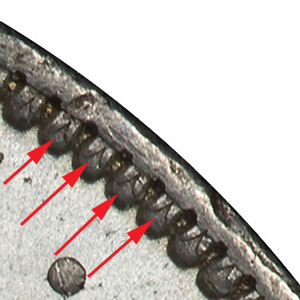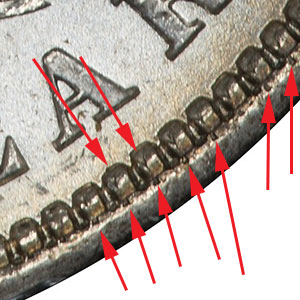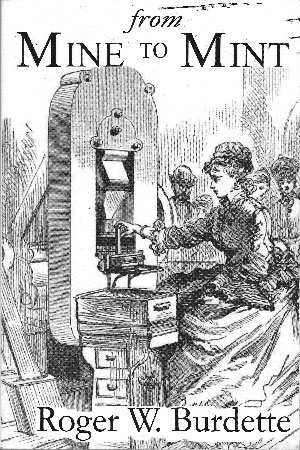
January 2016 - Welcome
Sources
Search
Contact
Home
Welcome
Click on year to expand
2022
2021
2020
2019
2018
2017
2016
2015
Welcome
In very late December we received word that we had four new VAM discoveries, numbers 63, 64, 65, and 66.
The documentation on those is now being updated on VAMworld and is already incorporated into our site. The description of those VAMs are as follows.
![]() VAM 63 - Doubled Obverse Stars, O Tilted Left
VAM 63 - Doubled Obverse Stars, O Tilted Left
All the left and right stars are slightly doubled toward the rim. As a die marker there are fine raised die pitting dots below the ear.
![]()
![]() VAM 64 - Doubled 18, Polished Forehead, O Set Left
VAM 64 - Doubled 18, Polished Forehead, O Set Left
There is a slightly doubled 18 with the 1 doubled on the lower surface of the upper crossbar, and the left 8 slightly doubled at the top left inside of the upper loop, and bottom outside of the lower loop. The left 8 has a short die chip at the top inside of the upper loop.
The left and right sides of the phrygian cap are slightly doubled at the top. Liberty's head profile is very slightly doubled from the front of the LIBERTY band, hair front, nose, and lips.
There are mostly horizontal die polishing lines on the forehead.
![]()
The date has a doubled 18-1 with the left 1 doubled slightly at the top right. The left 8 has a flat doubled top outside of the upper loop. The right 1 is doubled at the lower left of the vertical shaft. As a die marker there is a fine vertical polishing line on the right side of the upper hair curl.
On the reverse there are about ten mostly vertical fine line die scratch lines in the eagle's right wing with one on the wing opposite the left wreath top being most prominent.
![]()
![]() VAM 66 - Doubled Right 1 Bottom
VAM 66 - Doubled Right 1 Bottom
The right 1 is doubled as a strong notch in the middle of the base bottom. Both 8's are very slightly doubled at the lower left outside of the upper loop. The left 8 has a short die spike at the top left inside of the upper loop. EDS shows raised metal chips below 18 from the master die and on the working hubs in and above denticle spaces. This is the same obverse as VAM 54.
![]()
As always our thanks to VSS for helping identify the anomalies and to LVA for his analysis.
New Web Site Features
This month we added a number of new features to the web site to help with our study. Some of these we added just to make finding things over time much easier, and others we added to help with our goal of building visual representations of complex issues.
First, there is a new section in the upper menu labeled "Similitudes." Right now this section mirrors the sections of VAMworld where VAMs are grouped by characteristics, like "Spiked 8." We built our initial sections on these same groupings but added images to make discovery and identification easier. There are other logical groupings we will tackle in the future.
We also added a new section labeled "Studies" as a holding place for items we discuss in these news pages that we want to more easily access over time. Also included in that section is a PDF file for each of our VSS and LVA submissions.
Clashed Denticles or Not
Required Reading
We are sure these have been visible on other coins but we noticed them for the first time in a group of coins sent to LVA for analysis. There has been some discussion on VAMworld about clashed denticles, and of course varying opinions.

We first noticed this feature on coin 31359563 in our LVA submission for December of 2015 that turned out to be a Mint State 63 discovery coin for VAM 65. The appearance is denticles laying half overlapped on their neighbor. Although we were not aware of how this might happen, it looked a lot like the mysterious clashed denticles under discussion.
The picture above is from the coin obverse at about 2 o'clock. So the corresponding impression should be on the reverse at about 4 or 5 o'clock, and they are there.

But adding to the mystery for us is the series of small notches outside and in the rim that are square and indented. These notches line up with the denticle gap on the overlaying denticle impressions. They only appear on the reverse, which may or may not mean anything.
It was LVA's opinion that the impressions in question arose from the ejection process where the obverse die ejected the coin and in the process made contact with adjacent denticles.
This is a feature we have only started to look for, so we have no idea how often it repeats itself, but in just one batch of 9 random coins it appeared 3 times. It can also be seen clearly on coins 26241074 and 19005644 from the same batch. And then again, the New Orleans Mint was not known for exceptional production quality.
If either the ejection theory, or some other production related mystery is the source then these are not VAM varieties, but they sure are interesting.
To see more examples check our section on Clashed Denticles. As we have time we will add other coins we locate with these features to the mix.
It is obvious from this web site that we are doing a very deep dive into the 1881-O Morgan Dollar, and that we are serious about learning all we can about it.
Our need for understanding eventually led us to a book by Roger W. Burdette titled From Mine to Mint: American Coinage Operation and Technology 1833 to 1937. This is the only reference work we have found that deals with both the physical equipment used in coining and the evolution of processes used to create coinage. The work is throughly documented and appropriately footnoted.

As I was reading I started to turn down pages with facts of interest, only to discover that I had turned down so many pages that the book was becoming "fat" in the upper right corner.
As an added bonus a CD is included with the book that gives you a searchable reference to all the text and facts in the book in both desktop and mobile formats.
If you are serious about learning the details of the processes that produced the coins and resulting VAMs we collect, then we believe this should be required reading. If you want to know not just what, but also how various coin anomalies occurred then this is the book.
The book can be ordered from the Wizard Coin Supply web site and we obviously highly recommend it.
2015 Trends in Numbers & Values
We have updated the section detailing the grading trends and values for last year and there are no big surprises. The bulk of the value in the series is in just the top two grades (65 to 66 including all sub types) with 77%. Making no judgments on pricing, PCGS would value the 1881-O series at $4,158,346 as of December.
By number MS 63 grew the most, but it always does. Prices remained relatively flat, with coins below MS holding to slightly declining in value. Only in the top two grades were there any significant price movements, and the auction prices for these coins moved around, but was generally up.
This collection holds 39% of all coins from grades 01 through 45. So we continue to provide good value to anyone who would like to study grading.
Collection Status
Our collection is obviously aimed at some significant accumulation of 1881-O coins for study and we are on pace to include no fewer than 1% of each PCGS grade. There are areas where we just have to wait on the market to even see a particular grade, but they are coming slowly but surely.
Right now we are focused on keeping our 1% of grades MS62, MS63, and MS64 where most PCGS grading occurs for the 1881-O. At the same time we are moving up the ladder into MS65 where we need 7 coins for the 1% goal. All of our MS65 coins are not on the web site but we are up to 4. Our progress is slowed by price, but also VAM. We are trying to spread the varieties around in these upper grades and often they repeat when available or the seller is so fixed on an unreasonable price that acquisition is not smart. We have our eye on a MS65+ so hopefully this will inch us toward a complete set of grading coins.
Some of the VAM issues in the upper grades can be easily seen with VAM 28. There is a high probability if you are acquiring either a PL or DMPL coin it is a VAM 28. But for many grades there are fewer than 100 graded coins and trying to hit both a specific grade and VAM can be very expensive if you are grading raw coins.
On the overall VAM front we now have representative samples of just over 80% of the VAMworld listed varieties in our collection. Assuming the normal 80/20 rules apply the last 20% will be the most difficult, but also the most satisfying.
The coin totals on the graph to the right reflect 20 coins in the process of being added to the web site, but exclude coins where the VAM is not attributable or still under evaluation. By the end of January there will be 400 coins in the inventory that are shown on the web site.
For those 400 coins there are about 3,200 images for analysis and education.
Over the next few months this number will move closer to 500 coins, but then will slow dramatically as we attempt to tackle the top grades.

Getting Started
Collecting The 1881-O
The 1881-O VAMs




















